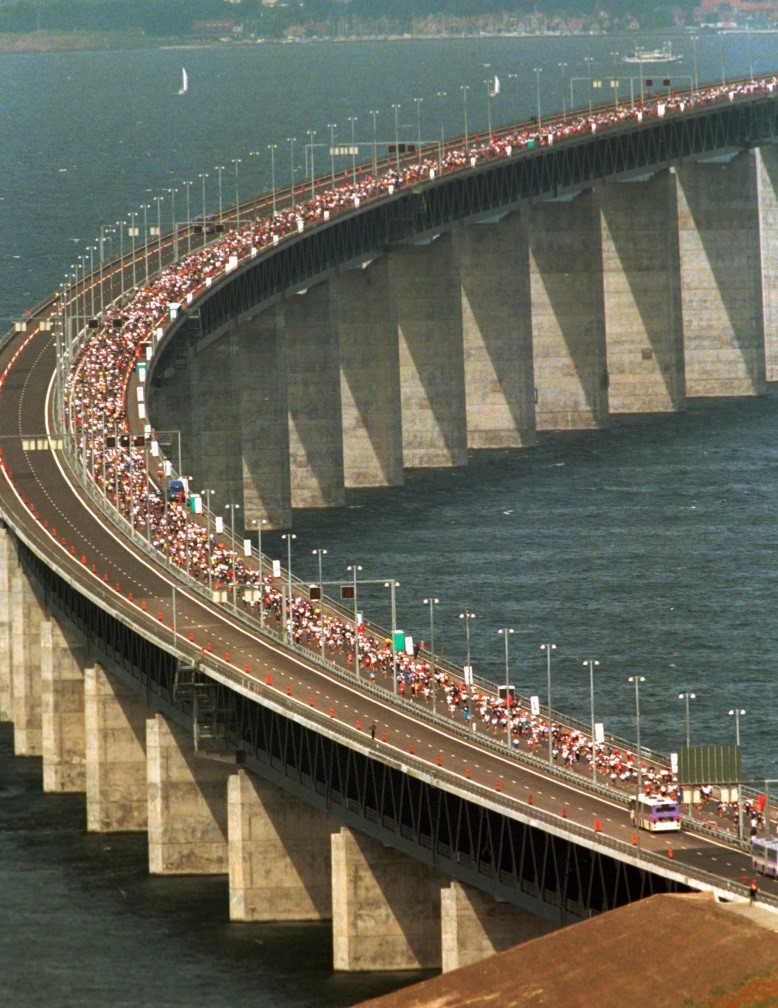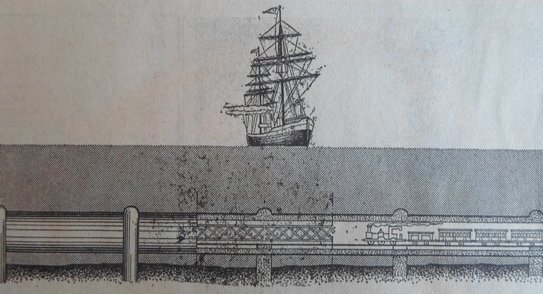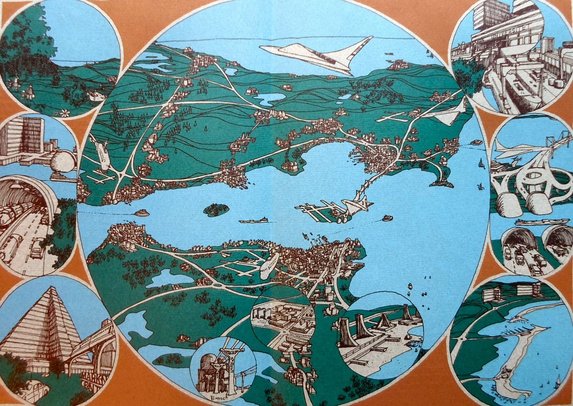A short history of the Oresund Bridge
A globally renowned icon, the bridge is in fact part rail/road bridge and part tunnel spanning the Oresund (or ‘The Sound’) between Denmark and Sweden. It was completed in 2000, but it has a rather long and convoluted history. It is a symbol of many and sometimes opposing things: Nordic cooperation in the economy and engineering, as well as the solving of grisly real or imagined crimes; freedom of movement, with thousands of commuters travelling both ways on a daily basis, as well as more recently policed borders with associated identification checks. Regardless of the different perspectives, it is an undeniable, physical link between continental Europe and the rest of the Nordics, and an image of cross-border relationships.

The opening of the bridge to traffic in 2000 had a huge social and economic impact on both Denmark and Sweden. The ten-minute ride encouraged a great deal of mobility and the flow of manpower, goods and services. The number of daily commuters grew from 3,291 in 2000 to 18,000 in 2010. The link has led to new opportunities: for example, in 2005 many Danes moved to Sweden to escape the sky-rocketing house prices in Denmark and commuted daily to work. A Danish labour shortage in the mid-2000s led to Danish employers recruiting Swedes. Even the economic crisis of 2008 did not significantly reduce the number of commuters. However, the increased number of refugees in 2015 was a staunch reminder that the Oresund bridge remains a physical border between two states. With the flow of refugees preferring Sweden to Denmark in which to apply for asylum, many of the 163,000 applicants heading towards the Oresund bridge passed through Denmark and were initially registered here rather than in Sweden (under the Dublin rules). In September 2015, the Danes decided to suspend registration outraging the Swedish government and, since December 2015, the Swedish police have been checking traveler identification on trains and buses crossing the Sound. The Danish police again implemented border controls due to security worries in late 2019.
Travel on water outweighed rail connections in the 19th century
Oresund is 'Øresund' in Danish and 'Öresund' in Swedish.
Prior to the nineteenth century, with the exception of some periods of peace between Denmark and Sweden, the Sound was most obviously characterized as a militarized border. However, after the Peace of Kiel in 1814 which brought the hostilities of the Napoleonic wars to an end, the steamboat Caledonia started regular trips between Malmö and Copenhagen in 1828. The first proposals for establishing a fixed link across the Sound date back to the second half of the nineteenth century. After the industrial revolution, the advancement in technology and the copious investment in educating engineers in the Nordic countries demonstrated that realizing such a titanic enterprise was possible, despite the costs being immense and the advantages modest. However, sea transportation won over new technology as it remained the easiest, cheapest, and most secure way of travel and communication. The technological wonders of bridges and tunnels, lyricized by engineers and businessmen alike in the nineteenth century, were not sufficient to disregard the expertise in navigation which had been developed for centuries.
With the invention of the train, the Sound, the Little Belt, and the Great Belt became three significant obstacles to the joining of the Scandinavian peninsula with the continental railways. The first proposal for establishing a train tunnel under the Sound was submitted by Swedish engineer Claes Adelsköld to the King of Sweden Karl XV in 1865. At that time, the Second Schleswig War and the absence of a fixed link from Zealand to the continent were considered sufficient reasons to turn down the proposal. Other similar projects, such as Rudolph Liljeqvist’s underwater railroad tunnel between Elsinore and Helsingborg (1889), were all similarly assessed as too expensive or useless. The steam ferry lines continued to be the preferred means of transport for passengers, goods and railway wagons, that from 1906 were shipped on special ferries on the Trelleborg-Sassnitz route.

PICTURE: Rudolph Liljeqvist's proposal for an underwater railroad steel tunnel between Elsinore and Helsinborg, 1889. Source: Rudolf Lilljeqvist, 'A suggestion for a direct rail connection between the Scandinavian countries and the European continent' [Förslag till direktjernvägsförbindelse mellan de skandinaviska länderna och den europeiska kontinenten] (Stockholm, 1889).
The car gave new impetuous to bridge plans in the early 1900s
In the twentieth century, the automobile gave new impetus to engineers to mark the Nordic landscape with greater rail- and road-infrastructure. For example, in 1935, the Little Belt Bridge connecting the Danish regions of Funen and Jutland was inaugurated. It comprised railroad tracks, two car lanes, and a pedestrian sidewalk - and the continent was one 'sound' closer.
Gustaf Evers and Ture Norder, two graduating engineers at the Royal Institute of Technology in Stockholm, were the first to present a project for a two car-lane bridge between Elsinore and Helsingborg (1935). But, large consortia often win over individual proposals. The following year, six giants of the Danish and Swedish engineering and construction industries, led by Danish engineer Rudolph Christiani, proposed two bridges: a combined rail- and road-bridge which connected Malmö, the Island of Slatholm, and Copenhagen, and a bridge over the Great Belt. The two governments turned down the proposal: the arms race of the second half of the Thirties, and the Second World War left no guarantee that the copious investment would not be bombed, sooner or later, blocking navigation entirely. The 16 unexploded bombs found in the Sound during the construction works of the 1990s prove that their concerns were grounded. From Nazi-occupied Denmark, proposals continued to be put forward to neutral Sweden and turned down for the similar reasons.
A post-war vision of Nordic cooperation
The bridge is a tangible product of a vision of the Oresund region as transnational. Such a region, comprising Zealand and Scania, has been imagined since at least the 1960s by local politicians, institutions, and entrepreneurs, as well as the cross-border cooperation and exchange that such a link would lead to. However, the journey to the vision being realized was fairly long and convoluted.
The Nordic Council, at its first meeting in Copenhagen in 1953, set out that the building of the Oresund bridge was a primary goal for favoring intra-Nordic mobility and shortening the distance between the Scandinavian peninsula and the continent. In 1954, the social democratic governments of the two states established a bilateral delegation to verify the technical and economic feasibility of the link. The delegation went on to, for example, obtain expertise from a wide range of scholars on forecasts of traffic volumes, and analyses on the geological composition of the seabed, and so on. At the same time, bilateral teams of entrepreneurs and politicians based in different cities were competing for promoting and advocating their projects for a fixed link and the surrounding region. Their hope was to become the new entry point to the Scandinavian peninsula – with all the chances of development this meant. By 1959, nine proposals had already been submitted to the Oresund delegation. Despite these bids, it proved difficult to get conclusive answers to the delegation’s many questions, making it challenging for the politicians to make a final decision in order for the project to be realised.
Various groups of society opposed the project. Firstly, the Scanian farmers complained that, with the development of infrastructures and housing, arable land would slowly disappear, most vocally in 1950s. Secondly, and linked to land-use, was the rise of environmental consciousness at the end of the 1960s. Several associations for the protection of the natural environment in Sweden and Denmark lobbied against the over-exploitation of land, questioning the consequences that newly built infrastructures, overpopulation, and traffic would have on the Sound’s nature, human health, and quality of life. Finally, the debate on the fixed link also created tension between regional and national actors in Sweden. Regional actors in Scania were reminded by the national government on more than one occasion that an eventual fixed link was aimed at satisfying the exigencies of international mobility, not only of local traffic. Then, in 1970s, the rise of more bourgeois parties in Sweden and of populist parties in Denmark (both staunch opponents of the project), and the international oil crisis further prevented an agreement on the project.
These sorts of issues meant that, from 1954 when the delegation originally began, its assessments had to start from the beginning nearly every decade.

PICTURE: The imagined Oresund region, as illustrated in the book 'Öresundsregionen år 2000' [The Oresund region in the year 2000], edited by the Oresund Council (1969). By then, the plan was to build an airport on the Island of Saltholm. Photo: Bengt Böckman ® Image used by kind permission of Heddi Böckman.
The vision for the Oresund Region finally realised in 1990s
In the early 1990s, the ratification of the project finally took place. However, even then the context was challenging; there was an economic crisis in Denmark, and Sweden was embroiled in an atmosphere of uncertainty regarding its EU accession. These tensions added to the environmental protests against the project, which had been going on since the early 1970s and had contributed to making the Oresund bridge a rather divisive issue. That said, the vision of the Oresund region and its economic potential won out this time.
The hope of increasing the volume of bilateral trade and of establishing the Sound as one of the main industrial, cultural, and touristic districts in Northern Europe ultimately convinced the political and economic establishment of Scania and Zealand to think in terms of region, and cross-bordering cooperation, rather than in the traditional terms of two separate countries. Filling the gap at the heart of the new region with a fixed link became pivotal for supporting this vision.
The realization of the project was helped by the European Roundtable of Industrialists (ERT) setting the groundwork in the 1980s. It appeared that the big European industries could influence the situation where local, regional and national initiatives, at both the private and public level, could not: the ERT lobbied Swedish and Danish politicians and the European Commission. It implemented a far-reaching advertisement campaign aimed at making the public more receptive to the idea of the need to fill the “missing links” between Europe and Scandinavia with good infrastructure links. Part of its proposal was the Scandinavian Link, which included the projects for the Oresund bridge, the Hallandsås Tunnel and the Swedish portion of the European highway 6. ERT had sufficient capital, and lobbying and marketing knowhow to align regional, national and international interests. The regional entrepreneurs and the majority of local institutions sided firmly with ERT, joining newly-constituted interest groups favorable to the establishing of the fixed link, and injecting capital into developing the Oresund region concept.
In 1991, the Danish and Swedish parliaments issued a bilateral agreement on the building of the Oresund bridge. In 1993, Øresundskonsortiet, a joint venture between the state companies Svedab (Sweden) and A/S Øresundsforbindelsen (Denmark), chose the two-level bridge designed by Danish architect Georg Rotne for ASO Group, a joint venture between private firms from Britain, France, and Denmark. In 1995, the construction work bid was won by Sundlink Contractors HB, a Swedish-German-Danish joint venture. The costs for the link’s construction, covered by a 4-billion-euro loan from the Danish and Swedish states to Øresundskonsortiet, are repaid from the fees levied for crossing the bridge.
Since 2000, the Oresund bridge has successfully connected Sweden and Denmark. The Danish-Swedish thriller TV-series Bron/Broen (2011-) has turned the bridge into a globally renowned icon of Norden. Its economic, societal and cultural benefits still appear to be clear and unquestioned, particularly compared to other Oresund projects that fell by the way side, such as, the Oresund Committee, and Oresund University. The history of the bridge illuminates different visions for society as well as intersecting local, regional, national, and international dimensions. Its real and imagined synergies of cross-bordering means that, while it remains a great feat of engineering and cooperation making a practical difference to people’s everyday lives, it also makes us contemplate the idea of state borders and freedom of movement, Nordic or otherwise.

PICTURE: The Oresund bridge (Øresundsbron) viewed from a plane taking off from Kastrup Airport, Copenhagen. The Oresund bridge is a mega-engineering project comprising a combined rail- and road-bridge and tunnel. Developed on two levels, it combines a 16 km long double-track railway and a four-lane motorway running on a 7.8 km long three-section, cable-stayed bridge from Malmö up to a height of 57 meters over the Flintrännan channel to the 4 km long artificial island of Peberholm. Peberholm connects the bridge to a 4 km immersed tunnel, the Drøgen tunnel, ending in a 1 km long peninsula on the coast of Copenhagen. Photo: Nick-D, Wikipedia Commons, CC BY-SA 4.0.
Further reading:
- Anders Linde-Laursen, Bordering. Identity Processes between the National and Personal (Abingdon: Ashgate, 2010).
- Francesco Zavatti, ?The Oresund bridge from imagination to innovation’, Memoria e Ricerca, 55, 2 (2017), pp. 313-330.
- Fredrik Nilsson, När en timme blir tio minuter (Lund: Historiska Media, 1999).
- Gustav Peebles, The Euro and its rivals. Currency and the Construction of a Transnational City (Bloomington: Indiana University Press, 2011).
- Markus Idvall, Kartors kraft. Regionen som samhällsvision i Öresundsbrons tid (Lund: Nordic Academic Press, 2000).
- Rosanna Farbøl, Astrid Elkjær Sørensen, Thorsten Borring Olesen, og Niels Wium Olesen, ?De politiske aftaler om de faste forbindelser over Storebælt og Øresund, 1972-2000’. [The political agreements on the fixed links across the Great Belt and the Sound, 1972-2000]. Danmarkshistorien.dk.